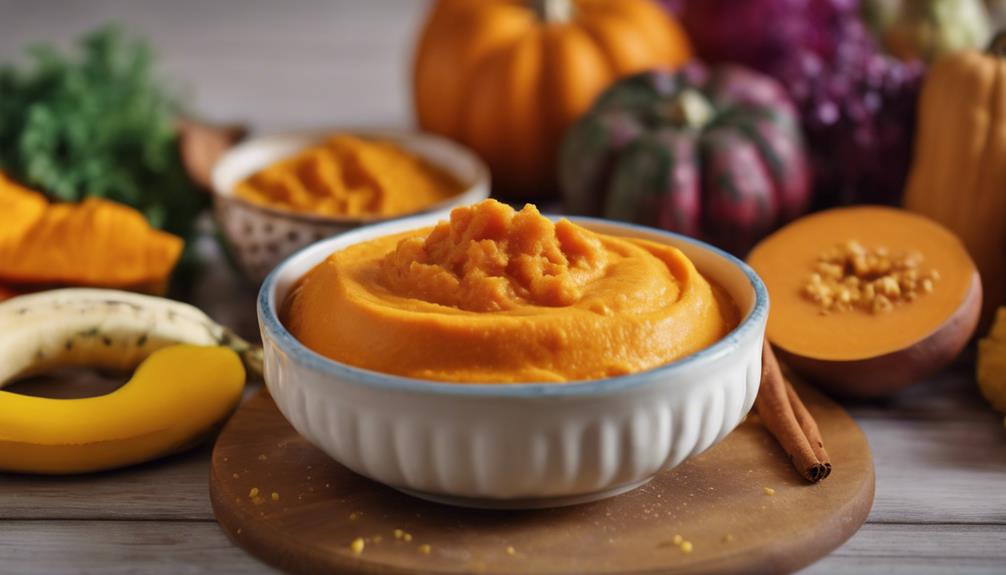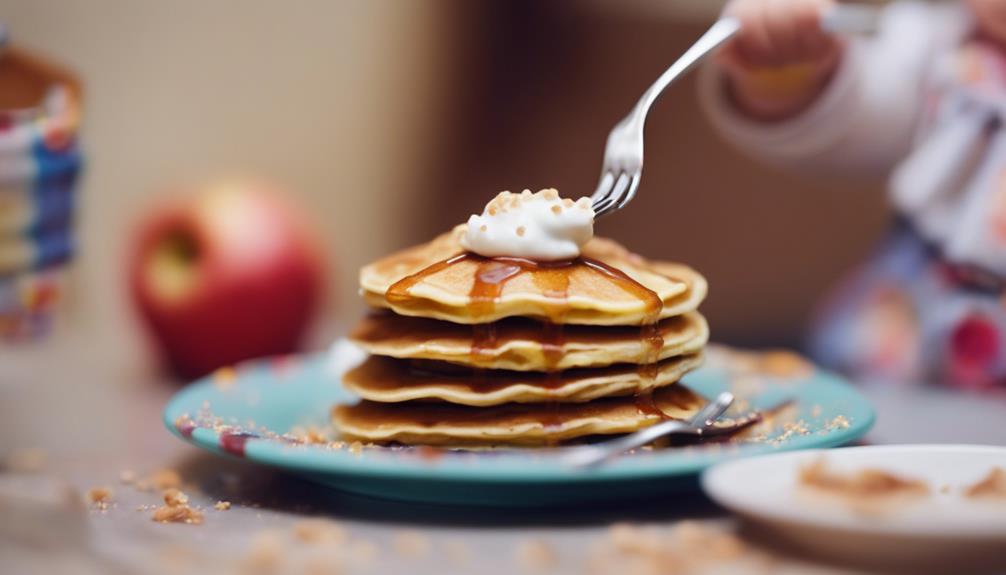A baby can enjoy tons of healthiness and tastiness with sweet potato puree. This dish has **fiber**, **antioxidants**, and **beta-carotene** that help them grow strong. Pick solid, smooth sweet potatoes like Beauregard or Garnet for the best quality. Roast them at 400°F for an hour or steam them till creamy. Try different tools like food processors or blenders for unique textures. Make it thinner with water or breast milk. Add this puree to muffins, oatmeal, or smoothies for a tasty and nutritious boost. Give your baby this super healthy treat and watch them thrive with joy!
Key Takeaways
- Sweet potato puree is packed with essential nutrients for your baby's growth and development.
- Its rich beta-carotene content supports vision and immune function in infants.
- Incorporating sweet potato puree into baby food offers a delicious and nutritious option.
- Experiment with different textures and flavors by mixing puree with various dishes.
- Enjoy the versatility of sweet potato puree in muffins, smoothies, pancakes, and more for added nutrients.
Sweet Potato Nutrition
Sweet potatoes provide important nutrients like fiber, vitamins, and antioxidants, making them an excellent choice for your baby's diet. These vibrant root vegetables aren't only sweet and delicious but also packed with significant nutrients vital for your baby's growth and development.
The beta-carotene found in sweet potatoes is converted into vitamin A in the body, supporting healthy vision and immune function in your little one.
Moreover, the high fiber content in sweet potatoes aids in digestion, promoting a healthy gut microbiome in babies. This helps in maintaining good digestive health and overall well-being.
Buying & Storing Tips

For best freshness and quality of sweet potatoes, consider these buying and storing tips.
When selecting sweet potatoes, opt for those with firm, unwrinkled skins to make sure they're fresh and of high quality. Popular varieties like Beauregard, Jewel, and Garnet offer different flavors and textures, with Jewel and Garnet being favored for their smoother consistency.
To maintain the freshness of your sweet potatoes, store them in a cool, dark place with good ventilation to prevent sprouting and spoilage. It's important to avoid refrigerating sweet potatoes, as the cold temperature can compromise their taste and texture.
Cooking Methods

Consider different cooking techniques to achieve varying textures when preparing sweet potato mash for your baby.
Roasting sweet potatoes at 400°F for 60 minutes produces an ideal texture for pureeing, resulting in a creamy consistency rich in nutrients.
If you're seeking a faster option, steaming diced sweet potatoes until tender is effective and preserves nutrients well.
Conversely, boiling peeled sweet potato chunks in water for about 15 minutes offers a quick method, although it may result in some nutrient loss.
Each cooking approach offers a distinct texture for the mash, so choose based on your desired consistency and time limitations.
Roasting results in a silky puree, steaming provides a slightly denser texture, while boiling can be the quickest but might impact the nutrient content.
Explore these cooking techniques to discover the perfect sweet potato mash texture for your little one while maintaining essential nutrients.
Pureeing Techniques

When pureeing sweet potatoes for your baby, utilize tools like food processors, blenders, immersion blenders, or mashers to achieve varying textures. Each tool offers a unique way to create the perfect consistency for your baby's sweet potato puree.
Here are some tips to help you master the art of pureeing sweet potatoes:
- Experiment with different tools: Try out a few different kitchen gadgets to see which one gives you the desired texture for your baby's food.
- Adjust the puree's texture: Add small amounts of water or breast milk while pureeing to achieve the ideal consistency for your little one.
- Consider the stage of feeding: Depending on your baby's age and readiness for solids, you may need to puree the sweet potatoes into a smoother or chunkier consistency.
Utilizing Sweet Potato Puree

Make the most of sweet potato puree by incorporating it into a variety of dishes to enhance both flavor and nutrition for your baby. Sweet potatoes are nutrient-rich and make a great homemade baby food option.
You can use sweet potato puree in recipes like muffins, cookies, and brownies to add moisture, natural sweetness, and extra nutrients. Mixing sweet potato puree with yogurt, oatmeal, or other purees introduces different flavors to your baby's diet and provides variety.
Adding sweet potato puree to smoothies, pancakes, waffles, or hummus not only enhances the nutritional content but also creates a creamy texture that babies enjoy. If the puree is too thick for your baby, you can adjust the consistency by adding a little water or milk.
Experimenting with different ways to incorporate sweet potato puree into your baby's meals will help them develop a taste for nutrient-dense foods early on.
Frequently Asked Questions
What Are the Nutritional Benefits of Sweet Potato for Baby?
Sweet potatoes offer rich nutrients for your baby. They provide fiber, vitamins A and C, potassium, and antioxidants. They support growth, immunity, and digestion. Plus, their sweet taste makes them a hit with little ones.
Is It OK for Baby to Eat Sweet Potato Everyday?
It's totally okay for your baby to eat sweet potatoes every day! They're packed with essential nutrients and flavors that support healthy growth and development. Enjoy the benefits of this nutritious food in your little one's diet!
How Do You Get the Best Nutrients From Sweet Potatoes?
To get the best nutrients from sweet potatoes, bake or steam them. These methods help retain important vitamins and minerals. By cooking sweet potatoes this way, you guarantee your baby receives maximum benefits for their growth and development.
What to Put With Sweet Potatoes for Baby?
To enhance sweet potatoes for baby, mix with apples for natural sweetness and vitamins. Try carrots for beta-carotene and vibrant color. Bananas add creaminess and potassium. A sprinkle of cinnamon or nutmeg introduces new flavors. Adding yogurt or coconut milk boosts healthy fats.
Conclusion
To wrap things up, sweet potato puree isn't just nutritious, it's a flavor explosion in your baby's mouth!
Packed with vitamins and minerals, this versatile ingredient is a must-have for any parent looking to provide their little one with a healthy and delicious meal.
So go ahead, whip up some sweet potato puree and watch your baby gobble it up with delight!











